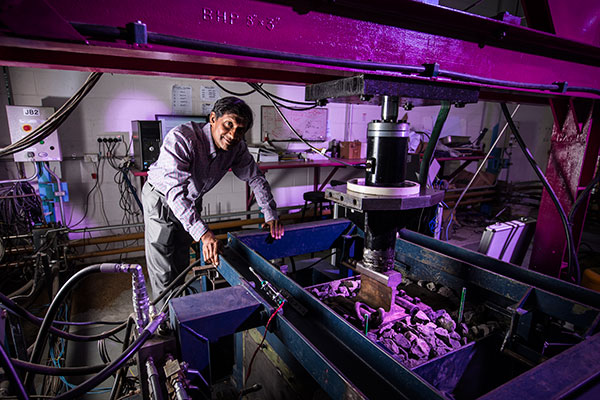February 17, 2015
Top honour recognises geotechnical engineer’s impact
Road and rail infrastructure research innovation rewarded with international lecture.

Professor Buddhima Indraratna, foundation Director of the Centre for Geomechanics and Railway Engineering in the Faculty of Engineering and Information Sciences(EIS), will deliver the First Proctor Lecture in Portugal next year during the International Transportation Geotechnics Conference in recognition of his major contributions to transport infrastructure research and development.
The International Society of Soil Mechanics and Geotechnical Engineering (ISSMGE) established the Ralph Proctor Lecture in August 2013 in Paris to recognise outstanding professionals in the field.
Ralph Roscoe Proctor was a US army engineer who through his dedicated efforts after World War I invented the theory of soil compaction for railroads, highways and dams.
He developed what is now known as the Proctor-test: a way of determining the desired water content of any type of soil to obtain its optimum compaction level when used for roads, railways and dams.
Proctor’s soil compaction theories are an essential component even in fundamental teaching for first year civil engineering students to this day, and his Proctor Test is familiar also to cricket tragics worldwide as one of the methods used to determine the life, pace and bounce in turf cricket pitches given the foundation soil conditions of the ground.
The prestigious award recognises Professor Indraratna’s decades of research excellence and outstanding professional contributions to research and impact on the way modern rail and road transport embankments are designed and built.
Through more than 500 peer-reviewed scholarly articles and six academic books, Professor Indraratna has been instrumental in changing industry practices, including revisions to some Australian and International Standards for improving road embankments and railways.
Professor Indraratna’s research-driven innovations that have been used to improve industry practices include the development of a landfill comprising recycled materials for reclamation work at the Port Kembla, now one of the busiest commercial harbours in New South Wales.
He has also pioneered the development of prefabricated vertical drains to rapidly drain soft soils to prevent water pressure build up and improve rail track stability, as well as developing design software for rail tracks.
The first such rail track over very deep estuarine clays was built in Sandgate, near Newcastle, for the first time in history. Similar concepts of soft soil improvement were applied for Port of Brisbane reclamation works to support future infrastructure development.
“If you are a civil engineer you know who Proctor is,” Professor Indraratna said. “Any type of compaction work – from building a driveway to the groundwork for rail tracks – is based on his theory.
“It’s an honour to be recognised with an award in recognition of a pioneer in our field.”
In recognition of his efforts towards rail innovations, he was also awarded the EH Davis Memorial lecture (2010), Chandra S Desai medal (2014), Eurasian University Medal (2012), the Engineers Australia Transport Medal (2011), and 2009 Business-Higher Education Round Table award sponsored by the Australian Commonwealth, among others.
Professor Indraratna’s research team was recently awarded a $1.2 million Federal Government Linkage grant to solve problems with soft clay along Australia’s coast, which creates challenges in designing and building transport infrastructure such as rail lines.
This together with an ARC-LIEF grant totalling $1.7 million will help build arguably the world's best and largest high-speed rail testing facility affiliated to UOW’s SMART Infrastructure Facility.